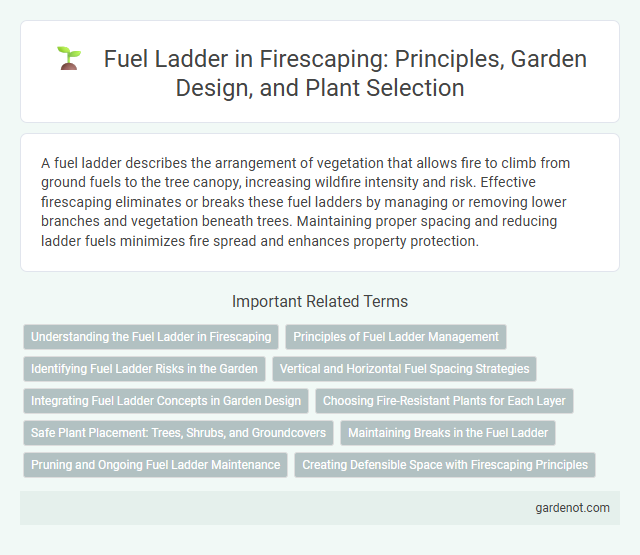A fuel ladder describes the arrangement of vegetation that allows fire to climb from ground fuels to the tree canopy, increasing wildfire intensity and risk. Effective firescaping eliminates or breaks these fuel ladders by managing or removing lower branches and vegetation beneath trees. Maintaining proper spacing and reducing ladder fuels minimizes fire spread and enhances property protection.
Understanding the Fuel Ladder in Firescaping
The fuel ladder in firescaping refers to the vertical arrangement of vegetation and combustible materials that allow wildfires to climb from the ground into the tree canopy. Breaking the fuel ladder by removing lower branches, thinning dense shrubbery, and spacing out plants reduces the risk of fire spreading rapidly through multiple layers of vegetation. Proper management of the fuel ladder is essential for creating defensible spaces and protecting properties from intense wildfire damage.
Principles of Fuel Ladder Management
Fuel ladder management involves strategically removing or reducing vegetation layers that allow wildfire to climb from low-lying grasses and shrubs to taller trees. Effective practices include pruning tree lower branches, clearing dead materials, and spacing plants to disrupt vertical continuity of fuels. Maintaining appropriate vertical and horizontal separation limits fire intensity and helps protect structures and landscapes from rapid fire spread.
Identifying Fuel Ladder Risks in the Garden
Identifying fuel ladder risks in the garden involves recognizing the vertical continuity of combustible materials, from ground-level vegetation to tree canopies, which can facilitate the rapid spread of wildfires. Key indicators include overgrown shrubs beneath low tree branches, dense ground cover close to tree trunks, and stacked firewood adjacent to plants. Mitigating these risks requires creating vertical and horizontal spacing between plants of differing heights to disrupt the fire's pathway.
Vertical and Horizontal Fuel Spacing Strategies
Fuel ladder management is essential for effective firescaping, involving both vertical and horizontal fuel spacing strategies to reduce fire spread. Vertical fuel spacing breaks the connection between ground fuels and tree canopies by removing low-hanging branches and shrubs, preventing flames from climbing. Horizontal fuel spacing creates gaps between vegetation patches, limiting the lateral spread of fire and increasing the chances of containment.
Integrating Fuel Ladder Concepts in Garden Design
Integrating fuel ladder concepts in garden design involves strategically arranging vegetation to reduce fire risk by preventing flames from easily climbing from ground fuels to tree canopies. Using drought-resistant, low-flammability plants in lower layers coupled with proper spacing disrupts the vertical continuity of fuels. This careful layering supports a defensible landscape that mitigates wildfire spread while maintaining aesthetic and ecological benefits.
Choosing Fire-Resistant Plants for Each Layer
Selecting fire-resistant plants for each layer of the fuel ladder minimizes wildfire risks by disrupting the vertical and horizontal continuity of flammable vegetation. Incorporate low-growing ground covers like sedums and native grasses, medium-height shrubs such as manzanita and California lilac, and fire-resistant trees like oaks and pines with high moisture content and low resin levels. Proper spatial arrangement and pruning enhance these plants' effectiveness in reducing fire spread through the landscape.
Safe Plant Placement: Trees, Shrubs, and Groundcovers
Safe plant placement in firescaping involves minimizing fuel ladder risks by strategically spacing trees, shrubs, and groundcovers to prevent fire from climbing from ground level to tree canopies. Using low-flammability plants and maintaining vertical and horizontal separation between vegetation layers reduces the likelihood of fire spread. Clear zones around structures should prioritize non-combustible groundcovers and well-irrigated plants to create effective fuel breaks.
Maintaining Breaks in the Fuel Ladder
Maintaining breaks in the fuel ladder significantly reduces wildfire risk by preventing the continuous vertical and horizontal flow of combustible materials from ground fuels to tree canopies. Clearing low-lying vegetation, pruning lower tree branches, and removing dead plant debris disrupt the fuel ladder and create defensible spaces that slow fire spread. Consistent maintenance of these breaks enhances the effectiveness of firescaping strategies by minimizing opportunities for fire to climb into the canopy.
Pruning and Ongoing Fuel Ladder Maintenance
Pruning involves selectively removing lower branches and vegetation to disrupt the fuel ladder, reducing the risk of fire spreading from ground to canopy. Ongoing fuel ladder maintenance requires regular inspection and trimming to prevent the accumulation of flammable materials that facilitate fire movement. Effective management of fuel ladders through consistent pruning enhances defensible space and supports fire-resistant landscaping strategies.
Creating Defensible Space with Firescaping Principles
Fuel ladder fuels, such as low-lying shrubs and tall trees, create pathways for fire to climb from the ground into the canopy, increasing wildfire risk. Eliminating or modifying fuel ladders by spacing vegetation strategically and pruning lower branches enhances defensible space, reducing fire intensity near structures. Proper firescaping principles prioritize vertical and horizontal fuel breaks to disrupt fire spread and protect property effectively.
Fuel ladder Infographic

 gardenot.com
gardenot.com